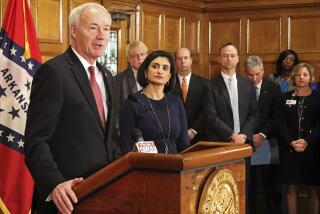Trump administration to allow states to require some Medicaid patients to work to be eligible
- Share via
Reporting from Washington — The Trump administration cleared the way Thursday for states to impose work requirements on many Americans who depend on Medicaid, the mammoth government health insurance program for the poor.
The much-anticipated move - which was strongly condemned by patient advocates, physicians and consumer groups — would mark the first time in the program’s half-century history that the government will require people to work in exchange for health coverage. In states that decide to impose the new requirement, it is widely expected to shrink Medicaid rolls.
The new plan sets the stage for a potentially long and contentious legal battle over the shape and purpose of a health program that more than 70 million Americans now depend on.
The administration outlined the work-requirement plan in a letter to state Medicaid officials that indicates the administration’s willingness to grant state requests to impose requirements on working-age, non-disabled Medicaid beneficiaries.
“Medicaid needs to be more flexible so that states can best address the needs of this population,” said Seema Verma, who oversees the Medicare and Medicaid programs at the Department of Health and Human Services and has long called for putting new requirements on Medicaid patients, including charging them more for their care.
Many patient advocates note that a small fraction of the people covered by Medicaid are of working age, non-disabled and currently unemployed. The main impact of the rules will be to subject poor people to stacks of paperwork that will drive some to drop coverage, the critics say.
“Medicaid was designed as a healthcare program, to provide vulnerable members of our society with access to care they badly need,” said Dr. Jack Ende, president of the American College of Physicians.
“Work requirements impose an additional, unnecessary barrier to allowing patients access to vital healthcare services for people who need access and coverage the most.… We need to work together to find ways to improve the program, instead of restrict it.”
Other groups criticizing the Trump administration’s plans included Public Citizen, Families USA and the advocacy arm of the American Cancer Society.
Several experts noted that threatening to strip coverage from poor people who are not working is inconsistent with the program’s legal mission to improve health and therefore could be subject to challenge in court.
The administration is nonetheless expected to quickly approve requests from as many as 10 states, all but one of which has a Republican governor.
The states are: Arizona, Arkansas, Indiana, Kansas, Kentucky, Maine, New Hampshire, North Carolina, Utah and Wisconsin.
Many other states, such as California, are not expected to impose work requirements.
Verma and other conservatives argue that forcing working-age Medicaid beneficiaries to work or seek work — a strategy used for years in other federally funded aid programs for the poor — will improve their health.
“States … want more flexibility to engage their working-age, able-bodied citizens on Medicaid,” Verma told a gathering of state Medicaid directors in November. “They want to develop programs that will help them break the chains of poverty and live up to their fullest potential. We support this.”
Critics of the Trump administration’s approach note that a growing body of evidence shows that Medicaid health coverage is helping many Americans improve their health and their finances, not holding them back, as Verma and other have suggested.
A large majority of Medicaid recipients — almost two-thirds — are children, elderly or disabled. They will be exempt from the new requirements.
At the same time, there is little evidence that many working-age Medicaid enrollees are choosing the government coverage instead of seeking work.
According to a recent analysis by the nonprofit Kaiser Family Foundation, 6 in 10 of the nearly 25 million working-age, non-disabled adults on Medicaid are already working full-time or part-time.
Of the remaining 10 million unemployed Medicaid enrollees, more than a third had an illness that prevented them from working, about another third were taking care of a family member, 15% were in school, 9% were retired, and 6% said they couldn’t find work.
Trump administration officials said Wednesday they would ensure that Medicaid enrollees in states with a work requirement would still get covered if they are involved in a “community engagement” activity, such as taking care of a family member, seeking work or job training.
Also protected would be Medicaid enrollees who are too ill to work, especially because of a drug addiction.
But those rules are certain to create significant administrative burdens. Medicaid enrollees will probably have to go through a new process of demonstrating that they are meeting the work or “community engagement” standards. Some won’t meet the requirements in time and will lose coverage, advocates predict.
“We know the upshot is people are going to be cut off,” said Jane Perkins, legal director of the National Health Law Program, a patient advocacy organization that is preparing to challenge the work requirements in court.
“We are going to sweep in people who are working or trying to get work because they haven’t filled out the necessary paperwork,” Perkins said. “And cutting off people from Medicaid is certainly not going to improve their health.”
UPDATES:
12:40 p.m.: This article was updated with additional reaction to the administration’s plan.
The article was first published at 4 a.m.
More to Read
Get the L.A. Times Politics newsletter
Deeply reported insights into legislation, politics and policy from Sacramento, Washington and beyond. In your inbox three times per week.
You may occasionally receive promotional content from the Los Angeles Times.











